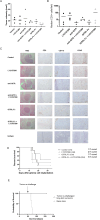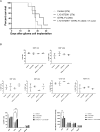Simultaneous TGF-β and GITR pathway modulation promotes anti-tumor immunity in glioma
- PMID: 40580238
- PMCID: PMC12206220
- DOI: 10.1007/s00262-025-04098-w
Simultaneous TGF-β and GITR pathway modulation promotes anti-tumor immunity in glioma
Abstract
The immunosuppressive tumor microenvironment of glioblastoma limits the effectiveness of most immunotherapies. Transforming growth factor (TGF)-β signaling drives tumor progression and prevents effective T cell activity. Notably, both regulatory T cells (Tregs) and effector T cells within glioblastoma and other tumors express high levels of the immune checkpoint receptor, glucocorticoid-induced tumor necrosis factor receptor (GITR), which modulates T cell activation and function. Combining GITR agonism with TGF-β inhibition may therefore offer a compelling approach to restore anti-tumor immunity. We evaluated the combined effects of TGF-β inhibition and GITR modulation using two different GITR agonists in syngeneic mouse glioma models. GITR modulation enhanced T cell activation, as shown by increased cytokine secretion and effector T cell proliferation in vitro. Combining GITR modulation with TGF-β inhibition amplified these effects, resulting in significantly stronger immune cell-mediated tumor cell killing compared to single-agent treatments. Combination therapy improved survival of glioma-bearing mice, with a higher fraction of long-term survivors compared to monotherapy. Surviving mice resisted tumor re-challenge, indicating durable adaptive immunity. In summary, dual targeting of TGF-β and GITR pathways synergistically enhances anti-tumor immunity in glioblastoma. This novel combination strategy demonstrates clinical potential by addressing the limitations of existing immunotherapies and offering a promising approach for durable and effective glioblastoma treatment.
Keywords: GITRL; Glioblastoma; Immunosuppression; Immunotherapy; Microenvironment.
© 2025. The Author(s).
Conflict of interest statement
Declarations. Conflict of interest: MW has received research grants from Novartis, Quercis and Versameb, and honoraria for lectures or advisory board participation or consulting from Anheart, Bayer, Curevac, Medac, Neurosense, Novartis, Novocure, Orbus, Pfizer, Philogen, Roche, and Servier. PR has received honoraria for lectures or advisory board participation from Alexion, Bristol-Myers Squibb, Boehringer Ingelheim, CDR-Life, Debiopharm, Galapagos, Laminar, Midatech Pharma, Novartis, Novocure, OM Pharma, QED, Roche, Sanofi, and Servier and research support from Merck Sharp and Dohme and TME Pharma. DL, MS, JF, and AE have nothing to disclose. Ethics approval: All animal experiments were authorized by the Veterinary Office of the Canton of Zurich.
Figures






Similar articles
-
Fc-enhanced anti-CTLA-4, anti-PD-1, doxorubicin, and ultrasound-mediated blood-brain barrier opening: A novel combinatorial immunotherapy regimen for gliomas.Neuro Oncol. 2024 Nov 4;26(11):2044-2060. doi: 10.1093/neuonc/noae135. Neuro Oncol. 2024. PMID: 39028616 Free PMC article.
-
IL-13Rα2/TGF-β bispecific CAR-T cells counter TGF-β-mediated immune suppression and potentiate anti-tumor responses in glioblastoma.Neuro Oncol. 2024 Oct 3;26(10):1850-1866. doi: 10.1093/neuonc/noae126. Neuro Oncol. 2024. PMID: 38982561
-
Inhibition of NFE2L1 Enables the Tumor-Associated Macrophage Polarization and Enhances Anti-PD1 Immunotherapy in Glioma.CNS Neurosci Ther. 2025 Jul;31(7):e70488. doi: 10.1111/cns.70488. CNS Neurosci Ther. 2025. PMID: 40677211 Free PMC article.
-
Systemic treatments for metastatic cutaneous melanoma.Cochrane Database Syst Rev. 2018 Feb 6;2(2):CD011123. doi: 10.1002/14651858.CD011123.pub2. Cochrane Database Syst Rev. 2018. PMID: 29405038 Free PMC article.
-
Immune factors and their role in tumor aggressiveness in glioblastoma: Atypical cadherin FAT1 as a promising target for combating immune evasion.Cell Mol Biol Lett. 2025 Jul 25;30(1):89. doi: 10.1186/s11658-025-00769-9. Cell Mol Biol Lett. 2025. PMID: 40713501 Free PMC article. Review.
References
-
- Mangani D, Weller M, Roth P (2017) The network of immunosuppressive pathways in glioblastoma. Biochem Pharmacol 130:1–9. 10.1016/j.bcp.2016.12.011 - PubMed
MeSH terms
Substances
Grants and funding
LinkOut - more resources
Full Text Sources
Medical

